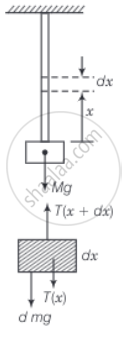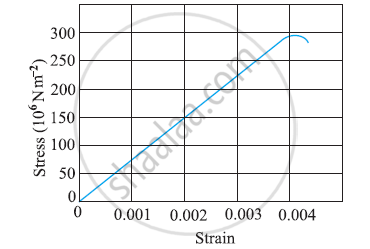Advertisements
Advertisements
Question
A steel wire of mass µ per unit length with a circular cross section has a radius of 0.1 cm. The wire is of length 10 m when measured lying horizontal, and hangs from a hook on the wall. A mass of 25 kg is hung from the free end of the wire. Assuming the wire to be uniform and lateral strains << longitudinal strains, find the extension in the length of the wire. The density of steel is 7860 kg m–3 (Young’s modules Y = 2 × 1011 Nm–2).
Solution
Consider the diagram when a small element of length dx is considered at x from the load (x = 0).

Let T(x) and T(x + dx) are tensions on the two cross-sections a distance dx apart, then – t(x + dx) + T(x) = dmg = μ dxg (where μ is the mass/length) ......(∵ dm = μdx)
dT = μgdx .....[∵ dT = T(x + dx) – T(x)]
⇒ T(x) = μgx + C .....(On integrating)
At x = 0, T(0) = Mg
⇒ C = mg
∴ T(x) = μgx + Mg
Let the length dx at x increase by dr, then
Young's modulus Y = `"Stress"/"Strain"`
`((T(x))/A)/((dr)/(dx)) = Y`
⇒ `(dr)/(dx) = 1/(YA) T(x)`
⇒ `r = 1/(YA) int_0^L (μgx + Mg)dx`
= `1/(YA) [(μgx^2)/2 + Mgx]_0^L`
= `1/(YA)[(mgL^2)/2 + MgL]` ......(m is the mass of the wire)
`A = pi xx (10^-3)^2 m^2`
`Y = 200 xx 10^9 Nm^-2`
`m = pi xx (10^-3)^2 xx 10 xx 7860` kg
∴ `r = 1/(2 xx 10^11 xx pi xx 10^-6)` ......`[(pi xx 786 xx 10^-3 xx 10 xx 10)/2 + 25 xx 10 xx 10]`
= `[196.5 xx 10^-6 + 3.98 xx 10^-3]`
= 4 × 10–3 m
APPEARS IN
RELATED QUESTIONS
The figure shows the strain-stress curve for a given material. What are (a) Young’s modulus and (b) approximate yield strength for this material?

A wire elongates by 1.0 mm when a load W is hung from it. If this wire goes over a a pulley and two weights W each are hung at the two ends, he elongation of he wire will be
Consider the situation shown in figure. The force F is equal to the m2 g/2. If the area of cross section of the string is A and its Young modulus Y, find the strain developed in it. The string is light and there is no friction anywhere.

The temperature of a wire is doubled. The Young’s modulus of elasticity ______.
Identical springs of steel and copper are equally stretched. On which, more work will have to be done?
What is the Young’s modulus for a perfect rigid body ?
A truck is pulling a car out of a ditch by means of a steel cable that is 9.1 m long and has a radius of 5 mm. When the car just begins to move, the tension in the cable is 800 N. How much has the cable stretched? (Young’s modulus for steel is 2 × 1011 Nm–2.)
If the yield strength of steel is 2.5 × 108 Nm–2, what is the maximum weight that can be hung at the lower end of the wire?
A steel rod of length 2l, cross sectional area A and mass M is set rotating in a horizontal plane about an axis passing through the centre. If Y is the Young’s modulus for steel, find the extension in the length of the rod. (Assume the rod is uniform.)
In nature, the failure of structural members usually result from large torque because of twisting or bending rather than due to tensile or compressive strains. This process of structural breakdown is called buckling and in cases of tall cylindrical structures like trees, the torque is caused by its own weight bending the structure. Thus the vertical through the centre of gravity does not fall within the base. The elastic torque caused because of this bending about the central axis of the tree is given by `(Ypir^4)/(4R) . Y` is the Young’s modulus, r is the radius of the trunk and R is the radius of curvature of the bent surface along the height of the tree containing the centre of gravity (the neutral surface). Estimate the critical height of a tree for a given radius of the trunk.
